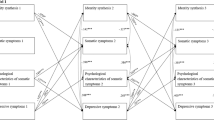Abstract
By drawing from literature on identity development as well as on self-discrepancy, the present study aimed to investigate variations in the magnitude of self-belief discrepancies among adolescents with different levels of identity development. The respondents consisted of 336 male and female adolescents, from 5 private secondary schools, ranging in age from 14 to 18 years (M = 15.98, SD = 0.89). Four levels of identity status (Achieved, Moratorium, Foreclosed, and Diffused identity status) were used as the method of identity classification in this study. Four types of self-discrepancies (Actual/Ideal (own), Actual/Ideal (other), Actual/Ought (own), and Actual/Ought (other) self-discrepancy) were also obtained. Multivariate analyses of variance showed that respondents with different identity statuses significantly varied on the magnitude of self-discrepancy experienced. The Foreclosed and Achieved statuses were found to have lower levels of self-belief discrepancy than the Moratorium and Diffused statuses. However, most of the significant differences among the statuses were for the Actual/Ideal (own) and Actual/Ideal (other) self-discrepancies. These results indicate that identity development is related to the magnitude of self-belief discrepancy. However, further research with more developed instruments is needed to explore this relationship more fully.
Similar content being viewed by others
REFERENCES
Adams, G. R. (1998). The Objective Measure of Ego Identity Status: A Manual on Theory and Test Construction. Unpublished manuscript, University of Guelph, Canada.
Bracken, B. A. (ed.) (1996). Handbook of Self-Concept: Developmental, Social and Clinical Considerations. Wiley, New York.
Bourne, E. (1978a). The state of research on ego identity: A review and appraisal. Part I. J. Youth Adolesc. 7: 223–251.
Bourne, E. (1978b). The state of research on ego identity: A review and appraisal. Part II. J. Youth Adoles. 7: 371–392.
Erikson, E. H. (1963). Childhood and Society (2nd edn.). Norton, New York.
Erikson, E. H. (1971). Identity, Youth and Crisis. Faber, London.
Frank, S. J., Pirsch, L. A., and Wright, V. C. (1990). Late adolescents' perceptions of their relationships with their parents: Relationships among de-idealization, autonomy, relatedness, and insecurity and implications for adolescent adjustment and ego identity status. J. Youth Adolesc. 19: 571–588.
Grotevant, H. D., and Adams, G. R. (1984). Development of an objective measure to assess ego identity in adolescence: Validation and replication. J. Youth Adolesc. 13: 419–438.
Grotevant, H. D., and Cooper, C. R. (1985). Patterns of interaction in family relationships and the development of identity exploration in adolescence. Child Dev. 56: 415–428.
Higgins, E. T. (1987). Self-discrepancy: A theory relating self and affect. Psychol. Rev. 94: 319–340.
Higgins, E. T., Bond, R. N., Klein, R., and Strauman, T. (1986). Self-discrepancies and emotional vulnerability: How magnitude, accessibility, and type of discrepancy influences affect. J. Pers. Soc. Psychol. 51: 5–15.
Higgins, E. T., Klein, R., and Strauman, T. (1985). Self-concept discrepancy theory: A psychological model for distinguishing among different aspects of depression and anxiety. Soc. Cogn. 3: 51–76.
Hult, R. E. (1979). The relationship between ego identity status and moral reasoning in university women. J. Psychol. 103: 203–207.
Jones, R. M., and Streitmatter, J.L. (1987).Validity and reliability of the EOM-EIS for early adolescents. Adolescence 22: 647–659.
Keppel, G. (1991). Design and Analysis: A Researcher's Handbook (3rd edn.). Prentice Hall, New Jersey.
Kroger, J. (1993). Ego identity: An overview. In Kroger, J. (ed.), Discussions on Ego Identity. Erlbaum, NJ, pp. 1–20.
Kroger, J. (1996). Identity in Adolescence: The Balance Between Self and Other (2nd edn.). Routledge, London.
Low, J. M. (1999). Differences in cognitive complexity of adolescents with foreclosed and achieved identity status. Psychol. Rep. 85: 1093–1099.
Marcia, J. E. (1966). Development and validation of ego-identity status. J. Pers. Soc. Psychol. 3: 551–558.
Marcia, J. E. (1980). Identity in adolescence. In Adelson, J. (ed.), Handbook of Adolescent Psychology. Wiley, Brisbane, pp. 159–187.
Marcia, J. E., Waterman, A. S., Matteson, D. R., Archer, S. L., and Orlofsky, J. L. (1993). Ego Identity: A Handbook for Psychosocial Research. Springer-Verlag, New York.
McAdams, D. P. (1997). The case of unity in the (post) modern self. In Ashmore, R. D. and Jussim, L. (eds.), Self and Identity: Fundamental Issues. Oxford University Press, New York, pp. 46–78.
Podd, M. H. (1972). Ego identity status and morality: The relationship between two developmental constructs. Dev. Psychol. 6: 497–507.
Podd, M. H., Marcia, J. E., and Rubin, B. M. (1970). The effects of ego identity and partner perception on a prisoner's dilemma game. J. Soc. Psychol. 82: 117–126.
Row, I., and Marcia, J. E. (1980). Ego identity status, formal operations, and moral development. J. Youth. Adoles. 9: 87–99.
Stegarud, L., Solheim, B., Karlsen, M., and Kroger, J. (1999). Ego identity status in cross-cultural context: A replication study. Psychol. Rep. 85: 457–461.
Strauman, T. J., and Higgins, E. T. (1987). Automatic activation of self-discrepancies and emotional syndromes: When cognitive structures influence affect. J. Pers. Soc. Psychol. 53: 1004–1014.
Tabachnick, B. G., and Fidell, L. S. (1996). Using Multivariate Statistics (3rd edn.). Harper Collins, New York.
Tangney, J. P., Niedenthal, P. M., Covert, M.V., and Hill-Barlow, D. (1998). Are shame and guilt related to distinct self-discrepancies? A test of Higgins's (1987) Hypotheses. J. Pers. Soc. Psychol. 75: 256–268.
Waterman, A. S. (1982). Identity development from adolescence to adulthood: An extension of theory and a review of research. Dev. Psychol. 18: 341–358.
Waterman, A. S. (1984). The Psychology of Individualism. Praeger, New York.
Yoder, A. E. (2000). Barriers to ego identity status formation: A contextual qualification of Marcia's identity status paradigm. J. Adolesc. 23: 95–106.
Author information
Authors and Affiliations
Rights and permissions
About this article
Cite this article
Makros, J., McCabe, M.P. Relationships Between Identity and Self-Representations During Adolescence. Journal of Youth and Adolescence 30, 623–639 (2001). https://doi.org/10.1023/A:1010404822585
Issue Date:
DOI: https://doi.org/10.1023/A:1010404822585




